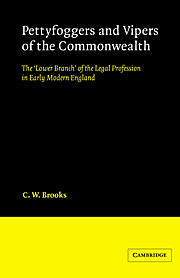 Pettyfoggers and Vipers of the Commonwealth
Pettyfoggers and Vipers of the Commonwealth Book contents
- Frontmatter
- Contents
- List of tables and figures
- Preface
- Abbreviations
- 1 Introduction
- 2 Lawyers and the royal courts in London during the reign of Elizabeth
- 3 The legal profession in the provinces
- 4 The increase in litigation
- 5 The causes of the increase in litigation
- 6 The increase in litigation and the legal profession
- 7 The attitudes of layman and attempts at reform
- 8 Clerkship, the inns of chancery, and legal education
- 9 Private practice
- 10 Public office and politics
- 11 Fees and incomes
- 12 Conclusion
- Appendix: Analysis of the social status of litigants in King's Bench and Common Pleas, 1560–1640
- Notes
- Select bibliography
- Index
- CAMBRIDGE STUDIES IN ENGLISH LEGAL HISTORY
- Frontmatter
- Contents
- List of tables and figures
- Preface
- Abbreviations
- 1 Introduction
- 2 Lawyers and the royal courts in London during the reign of Elizabeth
- 3 The legal profession in the provinces
- 4 The increase in litigation
- 5 The causes of the increase in litigation
- 6 The increase in litigation and the legal profession
- 7 The attitudes of layman and attempts at reform
- 8 Clerkship, the inns of chancery, and legal education
- 9 Private practice
- 10 Public office and politics
- 11 Fees and incomes
- 12 Conclusion
- Appendix: Analysis of the social status of litigants in King's Bench and Common Pleas, 1560–1640
- Notes
- Select bibliography
- Index
- CAMBRIDGE STUDIES IN ENGLISH LEGAL HISTORY
Summary
Throughout English history, the law, along with marriage, the church, and diligent management, has been reckoned by both contemporaries and historians as one of the principal means by which men of humble origins could hope to raise themselves into the national or at least the local elite. In this chapter, therefore, we will explore the economic prospects of members of the lower branch. The principal variables that must be considered are the differing levels of income of different groups within the profession, changes over time, and the relative importance of patrimony versus the fruits of professional practice in determining the success which individuals could achieve.
As we have seen in previous chapters, the lower branch was in fact composed of a range of practitioners which stretched from the officials of the courts at Westminster to the country attorney who worked in a village in one of the more remote parts of the realm. Consequently, the prospects offered by a legal career were extremely diverse. The office holders were at the apex of the profession in terms of wealth, and, given the Elizabethan boom in litigation, it is certain that legal offices were steadily gaining in value throughout the period. For example, an assessment of members of the legal profession for a ‘loan’ to Queen Elizabeth in 1589 was largely disdainful of the wealth of the twenty-four cursitors in Chancery, but by the time of Charles I each of these places was said to be worth some £300 p.a.
- Type
- Chapter
- Information
- Pettyfoggers and Vipers of the CommonwealthThe 'Lower Branch' of the Legal Profession in Early Modern England, pp. 227 - 262Publisher: Cambridge University PressPrint publication year: 1986
